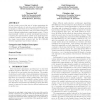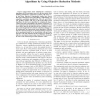44 search results - page 1 / 9 » The logarithmic hypervolume indicator |
FOGA
2011
12 years 8 months ago
2011
It was recently proven that sets of points maximizing the hypervolume indicator do not give a good multiplicative approximation of the Pareto front. We introduce a new “logarith...
EMO
2006
Springer
13 years 8 months ago
2006
Springer
The design of quality measures for approximations of the Pareto-optimal set is of high importance not only for the performance assessment, but also for the construction of multiobj...
PPSN
2010
Springer
13 years 3 months ago
2010
Springer
The hypervolume indicator is widely used to guide the search and to evaluate the performance of evolutionary multi-objective optimization algorithms. It measures the volume of the ...
CEC
2007
IEEE
13 years 11 months ago
2007
IEEE
— Hypervolume based multiobjective evolutionary algorithms (MOEA) nowadays seem to be the first choice when handling multiobjective optimization problems with many, i.e., at lea...
GECCO
2010
Springer
13 years 9 months ago
2010
Springer
In order to allow a comparison of (otherwise incomparable) sets, many evolutionary multiobjective optimizers use indicator functions to guide the search and to evaluate the perfor...


